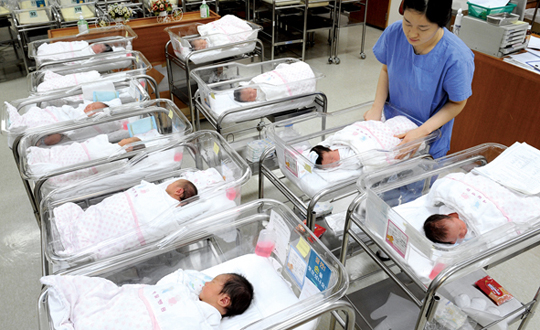Dwindling population
S.Korea to report first-ever population drop in 2021
The country's total population to trend downward from this year, eight years ahead of the projected timeline
By Dec 09, 2021 (Gmt+09:00)
2
Min read
Most Read
LG Chem to sell water filter business to Glenwood PE for $692 million


KT&G eyes overseas M&A after rejecting activist fund's offer


Kyobo Life poised to buy Japan’s SBI Group-owned savings bank


StockX in merger talks with Naver’s online reseller Kream


Meritz backs half of ex-manager’s $210 mn hedge fund



South Korea's total population in 2021 is set to decline for the first time since the country began collecting census data, hit by a sharp fall in birth rates and immigration since the onset of the COVID-19 pandemic.
The population in Asia's fourth-largest economy, including foreign students and workers, is estimated to shrink by 0.18% on-year to 51.7 million at the end of 2021, according to Statistics Korea on Thursday.
That is eight years ahead of the timeline projected two years ago by the statistics office for the country's total population to begin a downward trend.
Last year, South Korea reported its first-ever natural population decline, with the number of deaths outstripping that of births. Including the inflow of immigrants, however, the country's total population expanded by 0.14% in 2020.
The number of immigrants dropped by 63,000 this year, versus last year's decline of 58,000.
This year, the number of expected babies per South Korean woman is poised to drop to the lowest level of 0.82, versus the previous record low of 0.84 recorded in 2020, which was also the world’s lowest for the year. In 2021, the number of babies born is forecast at 261,000, compared with last year's 275,000.
That means the government's 380 trillion won ($323 billion) spending over the past 15 years on programs aimed at lifting the birth rate failed to reverse the decline.
TO RETURN TO LEVELS OF NEARLY A CENTURY PRIOR
Starting from last year, the country's total population is expected to shrink by an annual average of 60,000, which projects the number in 2070 at 37.7 million, similar to the population in 1979.
During the period, the working-age population, or those aged between 15 and 64, will likely decline by 3.6 million in total, equivalent to the current population of Busan, South Korea's second-largest city.
| Year | Estimated Population | Working-age Population (%) | Median Age |
| 2020 | 51,836,000 | 72.1% | 43.7 |
| 2030 | 51,199,000 | N/A | N/A |
| 2070 | 37,656,000 | 46.1% | 62.2 |
| Source: Statistics Korea | |||
The shrinking population is set to trap the South Korean economy into a vicious circle of falling consumption, investment and employment, undermining its growth potential.
The Organisation for Economic Co-operation and Development has projected South Korea's gross domestic product growth to slow to 1.9% per year between 2020 and 2030, compared with 2.8% between 2007 and 2020.
Write to Jin-gyu Kang at josep@hankyung.com
Yeonhee Kim edited this article.
More to Read
-
 S.Korea's potential growth rate drops to record low
S.Korea's potential growth rate drops to record lowSep 14, 2021 (Gmt+09:00)
3 Min read -
 Dwindling populationS.Korea’s birth rate decline accelerates to world’s lowest
Dwindling populationS.Korea’s birth rate decline accelerates to world’s lowestFeb 25, 2021 (Gmt+09:00)
4 Min read
Comment 0
LOG IN


